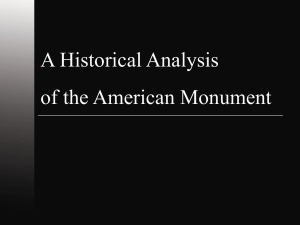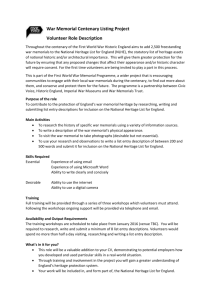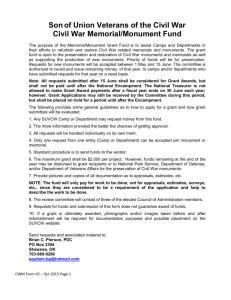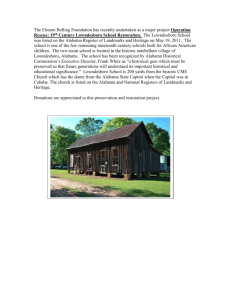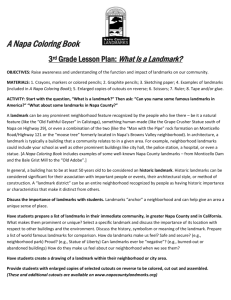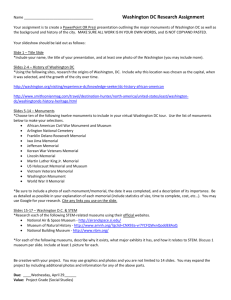Inventory of American Labor Landmarks
advertisement
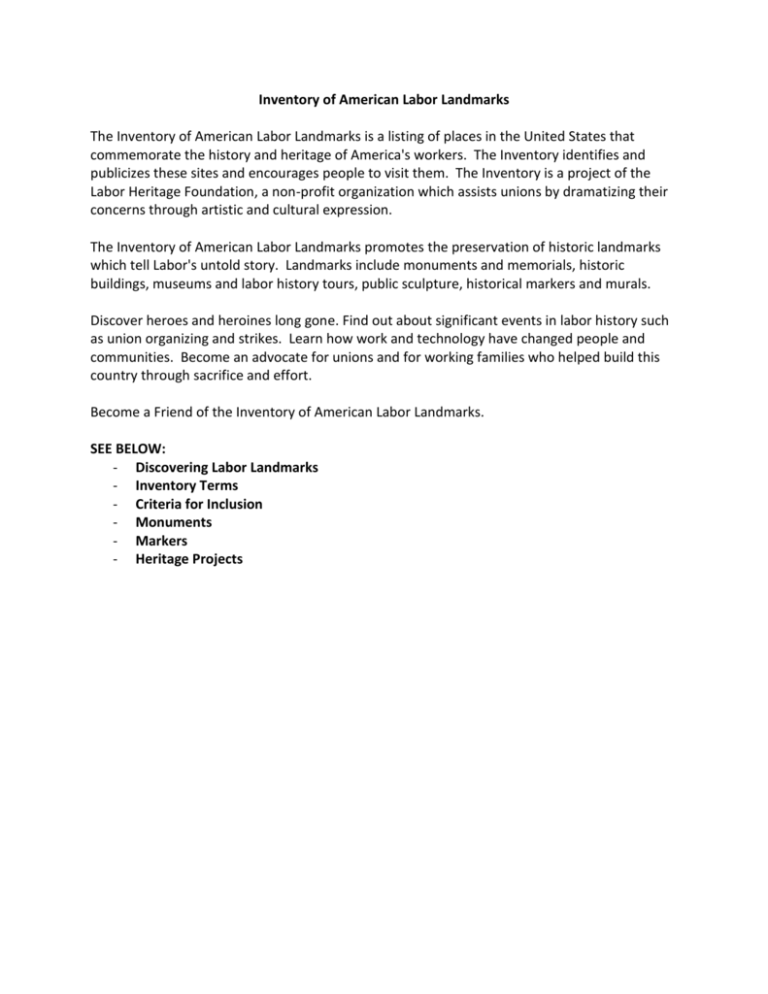
Inventory of American Labor Landmarks The Inventory of American Labor Landmarks is a listing of places in the United States that commemorate the history and heritage of America's workers. The Inventory identifies and publicizes these sites and encourages people to visit them. The Inventory is a project of the Labor Heritage Foundation, a non-profit organization which assists unions by dramatizing their concerns through artistic and cultural expression. The Inventory of American Labor Landmarks promotes the preservation of historic landmarks which tell Labor's untold story. Landmarks include monuments and memorials, historic buildings, museums and labor history tours, public sculpture, historical markers and murals. Discover heroes and heroines long gone. Find out about significant events in labor history such as union organizing and strikes. Learn how work and technology have changed people and communities. Become an advocate for unions and for working families who helped build this country through sacrifice and effort. Become a Friend of the Inventory of American Labor Landmarks. SEE BELOW: - Discovering Labor Landmarks - Inventory Terms - Criteria for Inclusion - Monuments - Markers - Heritage Projects Discovering Labor Landmarks Can you find a labor landmark in your community? Are there places that tell stories about working people and their achievements? Do you know of any monuments to labor leaders and activists? Famous meeting places and union halls? Old industrial sites and workers' homes? Historic buildings and working class neighborhoods? Theaters and recreational areas where people rested and played? Labor landmarks may not be easily found. To search them out, one might need to slow down, ask directions and pause for reflection. Since 1992 the Inventory of American Labor Landmarks has been identifying and collecting information about sites in the U.S. associated with individuals and events in labor history. Located in the office of the Labor Heritage Foundation in Washington, DC the Inventory is in the process of cataloging the following: Monuments & memorials Historical markers Union halls & historic buildings Restored dwellings Public sculpture Museums & history tours Heritage projects Preservation Areas Murals Dig where you stand! The Inventory encourages people to visit historic places and make them a part of weekend outings or vacations. Teachers are urged to include labor landmarks in field trips and history classes. Unions are requested to invite their members to search for landmarks in their community or state. To be listed in the Inventory the landmark should contain a narrative element which describes labor history or heritage. The site should retain a physical, or spiritual, relationship with workers and unions. Workplaces, industrial sites and structures - factories, mills, mines, offices, etc. - are listed only if they explicitly illustrate work process, labor organization, worker skills and technological change. Places which feature agricultural labor or household labor are included. Inquiries and submissions should be addressed to: Inventory of American Labor Landmarks c/o Labor Heritage Foundation 815 16th St., NW Washington, D.C. 20006 Help us by submitting information about labor landmarks in your area and by becoming a Friend of the Inventory. Inventory Terms monument or memorial - architectural or sculptural object or plaque that commemorates a person an event or an action. Difficult to distinguish between these 2 terms so use the term that the source states. Sometimes monuments are vertical (Washington Monument) and memorials are horizontal (Lincoln Memorial) grave marker - a stone or plaque that marks the gravesite of an individual. historical marker - a sign, stone or plaque that marks a historic site or event. Includes roadside signs. union hall - a large room or building used for assembly of workers. dwelling - a building designed or used as the living quarters for 1 or more families. public sculpture - art representing figures and forms in relief or in 3-D. Not part of a private collection. Includes pieces located indoors and outdoors. plaque - a flat plate, slab or disc that is ornamented or engraved and added to or set into a surface. museum - an institution for the assembly and public display of any kind of collection, especially one of rare and/or educational value. history tour - an educational journey to the past. relief - an etching or sculpture that is raised above a background plate and not freestanding. preservation area - a significant concentration, linkage or continuity of sites, buildings, structures or objects united historically or aesthetically by plan or physical development. of a permanent scheme of interior decoration. heritage project - a work-in-progress that promotes the preservation of labor history sites and encourages cultural awareness through education. industrial site - any area devoted predominantly to manufacturing. Includes explicit narrative describing work process, labor organization, worker skills or technological change. mural - painting executed directly upon a wall surface or upon a panel or canvas for mounting upon a wall as part Inventory of American Labor Landmarks Criteria for Inclusion The Inventory of American Labor Landmarks is a listing of historic places in the United States that are associated with events or individuals that made contributions to American labor history. To be listed, a landmark should commemorate labor history or heritage. Categories of interest to the Inventory are landmarks which: 1. are associated with significant events in labor history such as strikes and lockouts, or the development of unions; 2. are affiliated with individuals who have made significant contributions to labor history such as labor and political leaders, or which contain a narrative element depicting the individual's specific relationship to the labor movement; 3. commemorate workers who have been injured or killed on the job; 4. are associated with the history of union organizing and political activities such as historically significant meeting places and union halls or places where rallies and marches took place. 5. are historically significant working class neighborhoods and communities; 6. are illustrative of work process, worker skill, or technological change such as industrial production, agricultural labor, and household labor, only if they are related to the human element of work, as distinguished from the mechanical development of industry and technology. To be listed, the landmark should contain a narrative element describing one or more of these categories, and that site should retain a physical or spiritual relationship with workers and unions. Examples of landmarks being inventoried are: monuments and memorials, historical markers, restored dwellings, labor and industrial museums, union halls, plaques, grave markers, murals and labor history tours. MONUMENTS Allegheny Arsenal Explosion Monument Pittsburgh, PA Memorializes the 43 girls who were killed in the arsenal explosion on Sept. 17, 1862. A total of seventy-five workers died in the explosion, making it the worst industrial accident associated with the Civil War. In Allegheny Cemetery on Butler St. American Federation of Teachers Building Chicago, IL The Teachers Union first office in Chicago. Located at 3 South Wabash. Birmingham Civil Rights Institute Birmingham, AL Located at 520 Sixteenth St. N., visitors to this gallery and museum journey through segregation and the civil rights movement. Across the street is the Sixteenth Street Baptist Church which was bombed in 1963 killing four girls; this infamous event happened less than 3 weeks after the historic March on Washington for Freedom and Jobs. Bass, Charlotta, Mural Los Angeles, CA Eva Cockcroft's mural honors women and labor of LA, especially Charlotta Bass, who organized the Industrial Council to fight for the rights of workers under the slogan, "Don't spend your money where you cannot work." Over the door of a private library which archives the papers of Bass and of the Eagle, a black-owned newspaper of the 30s. On the north wall is the mural "Solidarity has no borders" by Mike Alewitz. Boott Cotton Mills Museum, Lowell, MA The largest industrial museum in the nation outside the Smithsonian. On the grounds of Lowell National Historic Park, Boott Mill No. 6 ceased production in 1954. Chavez, Cesar Sculpture (proposed) Santa Monica National Recreation Area, CA A sculpture to memorialize Cesar Chavez, organizer and leader of the Farm Workers Union is still being created. China Wall of the Sierra near Donner Pass, CA A plaque dedicated in 1984, to workers of the trans-Sierra railroad. Exact location of the plaque is unknown yet at Donner Pass the retaining wall and fill still stand as a memorial to the Chinese workers who toiled to build this country's first transcontinental railroad in the late 1860s. Firefighters of Michigan Monument Roscommon, Mich. Signs on I-75 mark the way to the inscribed stone, dedicated to the firefighters who protect the lives and homes of Michigan citizens. Furuseth, Andrew, Memorial San Francisco, Calif. A bronze bust of union leader Andrew Furuseth, guards the outside entrance to the Sailors Union of the Pacific in San Francisco. Garment Worker Statue New York, N.Y. A garment worker sits at his sewing machine portraying generations of immigrant needletrades workers; 7th Ave. & 39th St. in Manhattan. Gompers, Samuel Memorial San Antonio, Tex. The AFL-CIO, in 1982, erected this statue to the founder of the American Federation of Labor; located on San Antonio's Riverwalk. Grape Crusher Statue Southern Napa County, CA--North of Southern Crossing at Soscol on State Rt. 29. A 15-foot sculpture depicts the barefoot figure of a winemaker operating a wine press. Created by Santa Fe artist, Gino Miles, to honor the Napa Valley farmworkers who labor in the vineyards of the winemaking region. Haymarket Martyrs' Monument Chicago, Ill. The Haymarket Martyrs' Monument in Forest Home Cemetery, known throughout the world, commemorates the activists executed for their participation in the largest demonstration in the U.S. for the 8 hour day in 1886. Henry, John, Monument Talcott, W. Va. The statue of John Henry, the steel driver, who in 1872 beat the steam drill and became the most sung about hero in American folklore, stands atop the Big Bend Tunnel on the C. & O. Railroad line. ICWU/URW Worker Memorial The International Chemical Workers Union and the United Rubber Workers Union unveiled this joint memorial on Workers Memorial Day, 1992. Dedicated to the members who have died in workplace tragedies. Jones, Mary Harris "Mother", Memorial Mount Olive, Ill. Flanked by 2 bronze statues of coal miners, a granite spire marks the grave of Mother Jones (1830-1930), labor's most famous organizer and once called "the most dangerous woman in America." Labor Hall of Fame Washington, DC Labor heroes and heroines are honored by the Dept. of Labor. Open Monday through Friday in the Francis Perkins Building on Constitution Ave. Letter Carriers Centennial Monument Milwaukee, Wis. Life-size statue of letter carriers honors the men and women who hand-deliver the mail through rain, sleet and snow. Ludlow Massacre Monument Ludlow, Colo. This somber monument marks the site where striking miners and their families were killed in their tent colony on April 20, 1914. McGuire, Peter, Memorial Merchantsville, N.J. The United Brotherhood of Carpenters & Joiners of America dedicated this memorial to their founder, Peter McGuire, in 1962. Memphis Strike of 1968 Monument Memphis, Tenn. This stone recognizes the AFSCME Memphis city workers who were on strike in 1968 when Dr. Martin Luther King came to their aid. Michigan Lumberman's Memorial near Tawes City, Mich. Located in a small park on Michigan's upper peninsula, overlooking the Au Sable River, this statue perpetuates the memory of Michigan lumber workers. Murphy, John, Memorial Denver, CO John Murphy (1982-1908), one of the first labor attorneys, successfully fought in the courts for the 8-hour day. Nicknamed "Eight Hour Murphy". Murray, Philip, Bridge Canonsburg, Pa. Spanning Chartiers Creek and near Curry Field, where steelworkers rallied in 1931, this bridge memorializes Philip Murray, founding member and past president of the United Steelworkers of America. Postal Workers' Monument Edmond, Okla. The fountain and statue recall the 14 postal workers killed on the job in a violent episode in 1986. Railroad Workers' Monument Bloomington, Ill. A five foot tall fire whistle commemorates thousands of railroad shop workers who contributed to building communities in central Illinois. Randolph, A. Philip, Memorial Boston, Mass. The bronze statue in the New Back Bay Station pictures A. Philip Randolph (1889-1979), civil rights leader, founder and first president of the Brotherhood of Sleeping Car Porters. Rooke, Sarah J., Monument Folsom, NM In honor of Sarah "Sally" Rooke, heroic telephone operator who , in 1908, gave her life in the line of duty. At age 65 she stayed at her post to notify citizens of rising flood waters. She died along with 17 other Folsomites. SEIU Bas Relief Washington, D.C. The Service Employees International Union headquarters building features a bas relief depicting labor's progress. Sponge Divers' Tribute Tarpon Springs, FL Plaque and statue honoring divers from twelve Grecian Isles who settled in Tarpon Springs to develop a sponge industry at the turn of the century. The Greek divers revolutionized the sponge industry by introducing to the United States the pressurized diving suits. The industry died when DuPont marketed its first synthetic sponge. Talbot, Tom, Bust Atlanta, Ga. In Grant Park you will find the bust of Tom Talbot, founder and first president of the International Association of Machinists. Triangle Fire Memorial Plaque New York, N.Y. Garment workers mark the site, near Washington Square, of the Triangle Shirtwaist Fire of March 25, 1911 where 146 lost their lives. Union Printers Home Colorado Springs, Colo. In 1891 the International Typographical Union constructed this home for union printers suffering from occupational disease; the Communications Workers of America now operate the home for retirees and their spouses. Union Tavern Milton, N.C. Thomas Day, an early 19th century free African-American cabinet maker who achieved recognition for the superior quality of his craftsmanship, used this workshop. White, John P., Gravesite Des Moines, IA Miners' leader in the Anthracite region of Pennsylvania, he fought for better working conditions and higher wages. National president of the UMWA from 1911-1917. Workers Memorial Statue Springfield, Ill. Dedicated on Workers Memorial Day, 1992, this 3500 lb. bronze statue, on the lawn of the state capitol, features 3 figures - an injured worker attended by a co-worker and a strong forward-looking individual representing the future. HISTORICAL MARKERS Bay View Martyrs Historical Marker, Milwaukee, Wis. The Wisconsin Labor History Society placed this marker in honor of those killed by the state militia in 1886 during a city-wide strike for the 8 hour day. Flint Sitdown Strike Historical Marker, Flint, Mich. The Michigan Labor History Society erected this marker to commemorate the sitdown strike of 1936-1937 which led to the United Auto Workers first contract with General Motors. Lattimer Massacre Historical Marker, Hazleton, Pa. Immigrant workers remember the site where Polish, Lithuanian and Slovak miners were killed and wounded while marching for collective bargaining in 1897. Northern Colorado Mine Workers Historical Marker, Lafayette, Colo. A sign at Highway 7 to Lafayette marks the Columbine Massacre where miners were killed while on picket duty during the strike of 1927. Sellins, Fannie Historical Marker, Brackenridge, Pa. Pittsburgh unionists located this marker at the entrance to Union Cemetery, near the grave of Fannie Sellins who was murdered by Coal & Iron police on the eve of the nationwide steel strike of 1919. Sylvis, William H. Historical Marker, Indiana, Pa. Labor history advocates placed a marker to William Sylvis, founder of the Molders' Union and the National Labor Union; on the present campus of Indiana University of Pennsylvania, it notes his birthplace in Indiana County, Pa. Triangle Fire Memorial Plaque, New York, N.Y. Garment workers mark the site, near Washington Square, of the Triangle Shirtwaist Fire of March 25, 1911 where 146 lost their lives. American Federation of Labor Building, Washington, D.C. The United Association of Journeyman and Apprentices of the Plumbing and Pipefitters Industry now occupy the former headquarters of the AFL from 1916 to 1956. [National Historic Landmark] Botto House National Landmark, Haledon, N.J. During the Paterson Silk Strike of 1913, immigrants Pietro & Maria Botto invited union leaders to address workers from the balcony of this home. [NHL] Debs, Eugene V. Home, Terre Haute, Ind. Until his death in 1926, the founder of industrial unionism in the U.S. and the Socialist Party's candidate in 5 presidential elections lived here. [NHL] Jones, Mother Prison Site, Pratt, W. Va. During the Paint Creek-Cabin Creek strike of 1912-1913, troopers arrested Mother Jones and held her in this house for 85 days. Kehoe, Jack Hibernian House, Girardville, Pa. Nestled in Pennsylvania's anthracite region, Jack "Blackjack" Kehoe owned this tavern; the state sentenced him to death in 1878 as a leader of the Molly Maguires. Mullaney, Kate House, Troy, N.Y. Kate Mullaney, president of the Collar Laundry Union of Troy - the first women's union in the U.S. - lived here during her organizing career, from 1865 to 1875. Textile Workers Union Hall, New York Mills, N.Y. No commemorative plaque signifies the origin of this apartment house in upstate New York built by striking members of the United Textile Workers of America, Local 763, as a union hall in 1916. Union Printers Home, Colorado Springs, Colo. In 1891 the International Typographical Union constructed this home for union printers suffering from occupational disease; the Communications Workers of America now operate the home for retirees and their spouses. HERITAGE PROJECTS (uncataloged) America's Industrial Heritage Project--Southwestern Pennsylvania, Altoona, Pa. Battle of Blair Mountain Historic Preservation Project, Charleston, W.Va. Battle of Matewan Heritage Project, Matewan, W.Va. Haymarket Tragedy Landmark Designation Project, Chicago, Ill. 1892 Homestead Strike Centennial, Homestead, Pa. Women's History Landmark Project, Washington, D.C.


